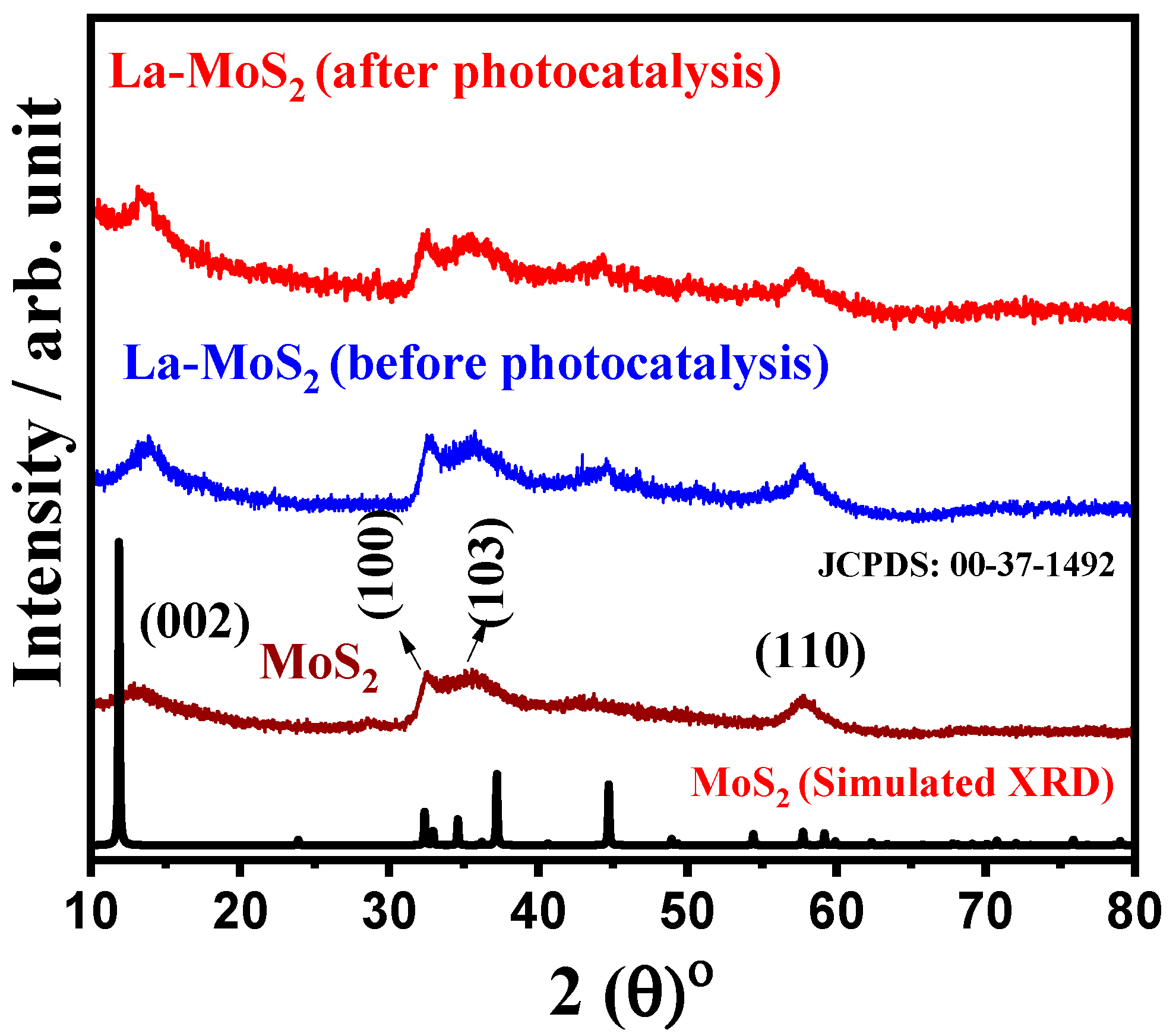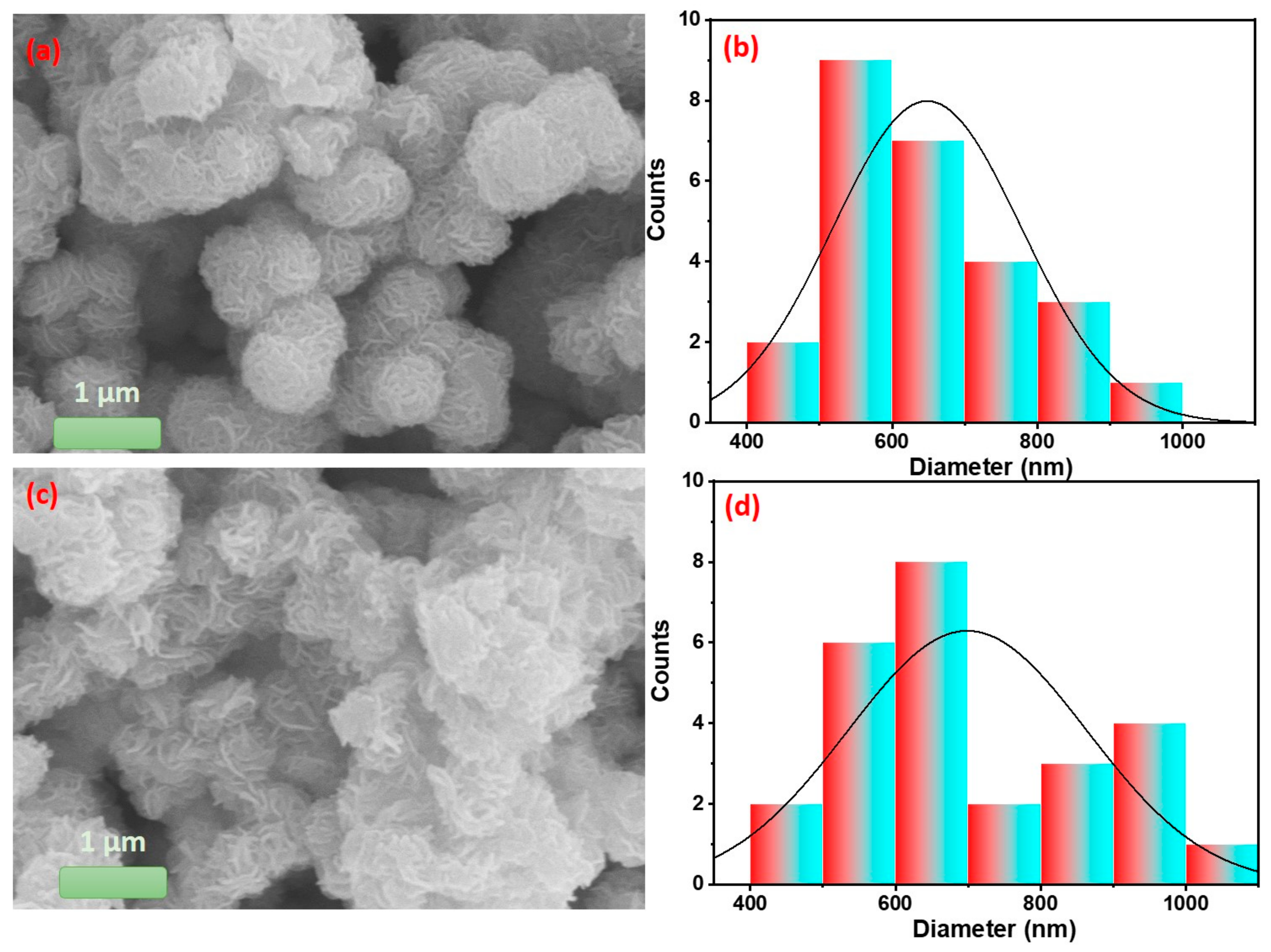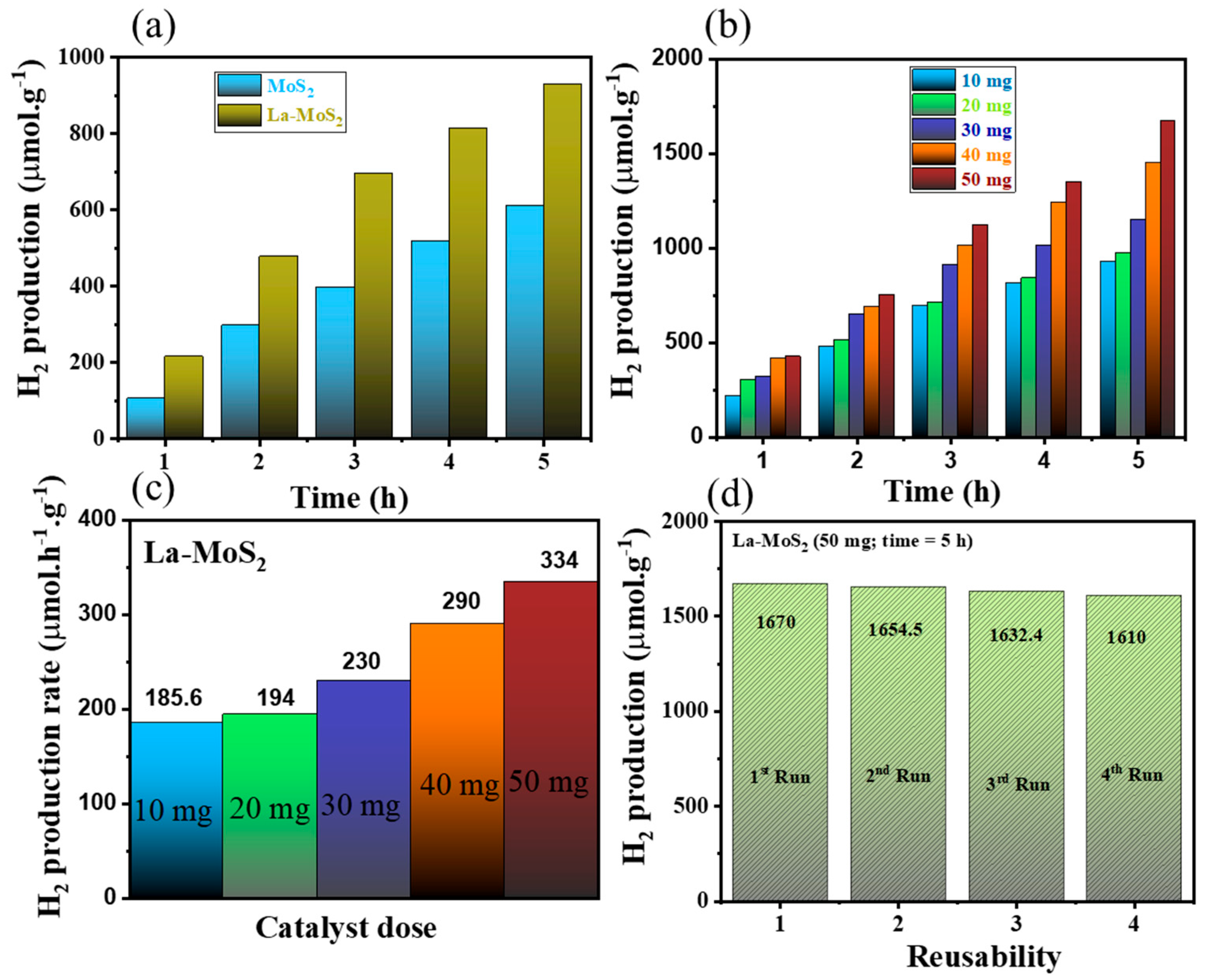Hydrothermal Synthesis of La-MoS2 and Its Catalytic Activity for Improved Hydrogen Evolution Reaction
Abstract
1. Introduction
2. Results and Discussion
2.1. Material Characterization
2.2. Photocatalytic Performance of La-MoS2
3. Materials and Methods
3.1. Materials
3.2. Synthesis of La-MoS2
3.3. Instruments
3.4. Photocatalytic H2 Evolution
4. Conclusions
Supplementary Materials
Author Contributions
Funding
Data Availability Statement
Acknowledgments
Conflicts of Interest
References
- Rahman, A.; Jennings, J.R.; Tan, A.L.; Khan, M.M. Molybdenum Disulfide-Based Nanomaterials for Visible-Light-Induced Photocatalysis. ACS Omega 2022, 7, 22089–22110. [Google Scholar] [CrossRef] [PubMed]
- Christoforidis, K.C.; Fornasiero, P. Photocatalytic Hydrogen Production: A Rift into the Future Energy Supply. Chem. Cat. Chem. 2017, 9, 1523–1544. [Google Scholar] [CrossRef]
- Lewis, N.S.; Nocera, D.G. Powering the planet: Chemical challenges in solar energy utilization. Proc. Natl. Acad. Sci. USA 2006, 103, 15729–15735. [Google Scholar] [CrossRef] [PubMed]
- Furukawa, H.; Yaghi, O.M. Storage of hydrogen, methane, and carbon dioxide in highly porous covalent organic frameworks for clean energy applications. J. Am. Chem. Soc. 2009, 131, 8875–8883. [Google Scholar] [CrossRef]
- Ganguly, P.; Harb, M.; Cao, Z.; Cavallo, L.; Breen, A.; Dervin, S.; Dionysiou, D.D. 2D Nanomaterials for Photocatalytic Hydrogen Production. ACS Energy Lett. 2019, 4, 1687–1709. [Google Scholar] [CrossRef]
- Gupta, U.; Rao, C. Hydrogen generation by water splitting using MoS2 and other transition metal dichalcogenides. Nano Energy 2017, 41, 49–65. [Google Scholar] [CrossRef]
- Teets, T.S.; Nocera, D.G. Photocatalytic hydrogen production. Chem. Commun. 2011, 47, 9268–9274. [Google Scholar] [CrossRef]
- Kumaravel, V.; Mathew, S.; Bartlett, J.; Pillai, S.C. Photocatalytic hydrogen production using metal doped TiO2: A review of recent advances. Appl. Catal. B 2019, 244, 1021–1064. [Google Scholar] [CrossRef]
- Noyan, O.F.; Hasan, M.M.; Pala, N. A Global Review of the Hydrogen Energy Eco-System. Energies 2023, 16, 1484. [Google Scholar] [CrossRef]
- Li, Y.; Somorjai, G.A. Nanoscale advances in catalysis and energy applications. Nano Lett. 2010, 10, 2289–2295. [Google Scholar] [CrossRef]
- Omer, A.M. Energy, environment and sustainable development. Renew. Sustain. Energy Rev. 2008, 12, 2265–2300. [Google Scholar] [CrossRef]
- Fujishima, A.; Honda, K. Electrochemical photolysis of water at a semiconductor electrode. Nature 1972, 238, 37–38. [Google Scholar] [CrossRef] [PubMed]
- Grätzel, M. Photoelectrochemical cells. Nature 2001, 414, 338. [Google Scholar] [CrossRef] [PubMed]
- Wang, X.; Maeda, K.; Thomas, A.; Takanabe, K.; Xin, G.; Carlsson, J.M.; Domen, K.; Antonietti, M. A metal-free polymeric photocatalyst for hydrogen production from water under visible light. Nat. Mater. 2009, 8, 76–80. [Google Scholar] [CrossRef]
- Zhou, X.; Liu, N.; Schmidt, J.; Kahnt, A.; Osvet, A.; Romeis, S.; Zolnhofer, E.M.; Marthala, V.R.R.; Guldi, D.M.; Peukert, W. Noble-Metal-Free Photocatalytic Hydrogen Evolution Activity: The Impact of Ball Milling Anatase Nanopowders with TiH2. Adv. Mater. 2017, 29, 1604747. [Google Scholar] [CrossRef]
- Zhu, Y.; Ling, Q.; Liu, Y.; Wang, H.; Zhu, Y. Photocatalytic H2 evolution on MoS2–TiO2 catalysts synthesized via mechanochemistry. Phys. Chem. Chem. Phys. 2015, 17, 933–940. [Google Scholar] [CrossRef]
- Kumar, S.; Kumar, A.; Rao, V.N.; Kumar, A.; Shankar, M.V.; Krishnan, V. Defect-Rich MoS2 Ultrathin Nanosheets-Coated Nitrogen-Doped ZnO Nanorod Heterostructures: An Insight into in-Situ-Generated ZnS for Enhanced Photocatalytic Hydrogen Evolution. ACS Appl. Energy Mater. 2019, 2, 5622–5634. [Google Scholar] [CrossRef]
- Hu, Y.; Yu, X.; Liu, Q.; Wang, L.; Tang, H. Highly Metallic Co-Doped MoS2 Nanosheets as an Efficient Cocatalyst to Boost Photoredox Dual Reaction for H2 Production and Benzyl Alcohol Oxidation. Carbon 2022, 188, 70–80. [Google Scholar] [CrossRef]
- Yusuf, M.; Song, S.; Park, S.; Park, K.H. Multifunctional Core-Shell Pd@Cu on MoS2 as a Visible Light-Harvesting Photocatalyst for Synthesis of Disulfide by S S Coupling. Appl. Catal. A 2021, 613, 118025. [Google Scholar] [CrossRef]
- Hu, J.; Zhang, C.; Li, X.; Du, X. An Electrochemical Sensor Based on Chalcogenide Molybdenum Disulfide-Gold-Silver Nanocomposite for Detection of Hydrogen Peroxide Released by Cancer Cells. Sensors 2020, 20, 6817. [Google Scholar] [CrossRef]
- Lai, H.; Ma, G.; Shang, W.; Chen, D.; Yun, Y.; Peng, X.; Xu, F. Multifunctional Magnetic Sphere-MoS2@Au Hybrid for Surface-Enhanced Raman Scattering Detection and Visible Light Photo-Fenton Degradation of Aromatic Dyes. Chemosphere 2019, 223, 465–473. [Google Scholar] [CrossRef] [PubMed]
- Gottam, S.R.; Tsai, C.-T.; Wang, L.-W.; Lin, C.-C.; Chu, S.-Y. Highly Sensitive Hydrogen Gas Sensor Based on a MoS2-Pt Nanoparticle Composite. Appl. Surf. Sci. 2020, 506, 144981. [Google Scholar] [CrossRef]
- Chi, M.; Zhu, Y.; Jing, L.; Wang, C.; Lu, X. Fabrication of Ternary MoS2-Polypyrrole-Pd Nanotubes as Peroxidase Mimics with a Synergistic Effect and Their Sensitive Colorimetric Detection of L-Cysteine. Anal. Chim. Acta 2018, 1035, 146–153. [Google Scholar] [CrossRef] [PubMed]
- Lin, T.; Zhong, L.; Guo, L.; Fu, F.; Chen, G. Seeing Diabetes: Visual Detection of Glucose Based on the Intrinsic Peroxidase-like Activity of MoS2 Nanosheets. Nanoscale 2014, 6, 11856–11862. [Google Scholar] [CrossRef] [PubMed]
- Liu, Y.; Xie, Y.; Liu, L.; Jiao, J. Sulfur vacancy induced high performance for photocatalytic H2 production over 1T@2H phase MoS2 nanolayers. Catal. Sci. Technol. 2017, 7, 5635–5643. [Google Scholar] [CrossRef]
- Okuno, Y.; Lancry, O.; Tempez, A.; Cairone, C.; Bosi, M.; Fabbri, F.; Chaigneau, M. Probing the nanoscale light emission properties of a CVD-grown MoS2 monolayer by tip-enhanced photoluminescence. Nanoscale 2018, 10, 14055–14059. [Google Scholar] [CrossRef]
- Deokar, G.; Rajput, N.S.; Vancsó, P.; Ravaux, F.; Jouiad, M.; Vignaud, D.; Cecchet, F.; Colomer, J.F. Large area growth of vertically aligned luminescent MoS2 nanosheets. Nanoscale 2017, 9, 277–287. [Google Scholar] [CrossRef]
- Pradhan, G.; Sharma, A.K. Anomalous Raman and photoluminescence blue shift in mono- and a few layered pulsed laser deposited MoS2 thin films. Mater. Res. Bull. 2018, 102, 406–411. [Google Scholar] [CrossRef]
- Marin, R.; Back, M.; Mazzucco, N.; Enrichi, F.; Frattini, R.; Benedetti, A.; Riello, P. Unexpected optical activity of cerium in Y2O3:Ce3+, Yb3+, Er3+ up and down-conversion system. Dalton Trans. 2013, 42, 16837. [Google Scholar] [CrossRef]
- Revathy, J.S.; Priya, N.S.C.; Sandhya, K.; Rajendran, D.N. Structural and optical studies of cerium doped gadolinium oxide phosphor. Bull. Mater. Sci. 2021, 44, 13. [Google Scholar] [CrossRef]
- Kumar, M.J.K.; Kalathi, J.T. Low-temperature sonochemical synthesis of high dielectric Lanthanum doped Cerium oxide nanopowder. J. Alloy. Compd. 2018, 748, 348–354. [Google Scholar] [CrossRef]
- Afanasiev, P.; Bezverkhy, I. Synthesis of MoSx (5 > x > 6) Amorphous Sulfides and Their Use for Preparation of MoS2 Monodispersed. Chem. Mater. 2002, 14, 2826–2830. [Google Scholar] [CrossRef]
- Chen, X.; Wang, X.; Wang, Z.; Yu, W.; Qian, Y. Direct sulfidization synthesis of high-quality binary sulfides (WS2, MoS2, and V5S8) from the respective oxides. Mater. Chem. Phys. 2004, 87, 327–331. [Google Scholar] [CrossRef]
- Riaz, K.N.; Yousaf, N.; Tahir, M.B.; Israr, Z.; Iqbal, T. Facile hydrothermal synthesis of 3D flower-like La-MoS2 nanostructure for photocatalytic hydrogen energy production. Int. J. Energy Res. 2019, 43, 491–499. [Google Scholar] [CrossRef]
- Radisavljevic, B.; Radenovic, A.; Brivio, J. Single-layer MoS2 transistors. Nat. Nanotechnol. 2011, 6, 147–150. [Google Scholar] [CrossRef]
- Schneider, J.; Matsuoka, M. Takeuchi Understanding TiO2 photocatalysis: Mechanisms and materials. Chem. Rev. 2014, 114, 9919–9986. [Google Scholar] [CrossRef]
- Galińska, A.; Walendziewski, J. Photocatalytic water splitting over Pt–TiO2 in the presence of sacrificial reagents. Energy Fuels 2005, 19, 1143–1147. [Google Scholar] [CrossRef]
- Xin, X.; Song, Y.; Guo, S.; Zhang, Y.; Wang, B.; Wang, Y.; Li, X. One-step synthesis of P-doped MoS2 for efficient photocatalytic hydrogen production. J. Alloys Compd. 2020, 829, 154635. [Google Scholar] [CrossRef]
- Hunge, Y.M.; Yadav, A.A.; Kang, S.-W.; Lim, S.J.; Kim, H. Visible light activated MoS2/ZnO composites for photocatalytic degradation of ciprofloxacin antibiotic and hydrogen production. J. Photochem. Photobiol. A Chem. 2023, 434, 114250. [Google Scholar] [CrossRef]
- Li, D.; Zeng, G.; Wu, Y.; Zhou, Z.; Guo, W.; Li, C. Au induced in-situ formation of ultra-stable 1T-MoS2 on polymeric carbon nitride toward promoted photocatalytic hydrogen production. Int. J. Hydrogen Energy 2023, 48, 34363–34369. [Google Scholar] [CrossRef]
- Xu, Y.; Ouyang, J.; Zhang, L.; Long, H.; Song, Y.; Cui, Y. Embedded 1T-rich MoS2 into C3N4 hollow microspheres for effective photocatalytic hydrogen production. Chem. Phys. Lett. 2023, 814, 140331. [Google Scholar] [CrossRef]
- Wei, X.; Wang, M.; Ali, S.; Wang, J.; Zhou, Y.; Zuo, R.; Zhong, Q.; Zhan, C. Enhanced photocatalytic H2 evolution on g-C3N4 nanosheets loaded with nitrogen-doped MoS2 as cocatalysts. Int. J. Hydrogen Energy 2024, 89, 691–702. [Google Scholar] [CrossRef]
- Wang, L.; Hu, Y.; Xu, J.; Huang, Z.; Lao, H.; Xu, X.; Xu, J.; Tang, H.; Yuan, R.; Wang, Z.; et al. Dual non-metal atom doping enabled 2D 1T-MoS2 cocatalyst with abundant edge-S active sites for efficient photocatalytic H2 evolution. Int. J. Hydrogen Energy 2023, 48, 16987–16999. [Google Scholar] [CrossRef]







| Photocatalysts | H2 Evolution Rate (µmol·h−1·g−1) | Light Source | Sacrificial Agent | Reference |
|---|---|---|---|---|
| La-MoS2 | 334 | 300 W; Xe lamp (λ = 420 nm) | Lactic acid | This study |
| P-MoS2 | 278.8 | 300 W; Xe lamp (λ = 420 nm) | Lactic acid | 38 |
| MoS2 | 99.4 | 300 W; Xe lamp (λ = 420 nm) | Lactic acid | 38 |
| MoS2 | 39 | 300 W; Xe lamp (λ = 420 nm) | SO32− | 39 |
| MoS2/ZnO | 235 | 300 W; Xe lamp (λ = 420 nm) | SO32− | 39 |
| ZnO | 22 | 300 W; Xe lamp (λ = 420 nm) | SO32− | 39 |
| g-C3N4 | 54 | 300 W; Xe lamp (λ = 420 nm) | Methanol | 40 |
| MoS2 | 185 | 300 W; Xe lamp (λ = 420 nm) | Methanol | 40 |
| MoS2/g-C3N4 | 441.3 | 300 W; Xe lamp (λ = 420 nm) | Triethanolamine | 41 |
| MoN1.2xS2−1.2x@g-C3N4 | 360.4 | 300 W; simulated solar light | Triethanolamine | 42 |
| O, P–MoS2 | 339.3 | LED light; λ = 420 nm | Triethanolamine/acetonitrile | 43 |
Disclaimer/Publisher’s Note: The statements, opinions and data contained in all publications are solely those of the individual author(s) and contributor(s) and not of MDPI and/or the editor(s). MDPI and/or the editor(s) disclaim responsibility for any injury to people or property resulting from any ideas, methods, instructions or products referred to in the content. |
© 2024 by the authors. Licensee MDPI, Basel, Switzerland. This article is an open access article distributed under the terms and conditions of the Creative Commons Attribution (CC BY) license (https://creativecommons.org/licenses/by/4.0/).
Share and Cite
Chaudhary, A.; Khan, R.A.; Almadhhi, S.S.; Alsulmi, A.; Ahmad, K.; Oh, T.H. Hydrothermal Synthesis of La-MoS2 and Its Catalytic Activity for Improved Hydrogen Evolution Reaction. Catalysts 2024, 14, 893. https://doi.org/10.3390/catal14120893
Chaudhary A, Khan RA, Almadhhi SS, Alsulmi A, Ahmad K, Oh TH. Hydrothermal Synthesis of La-MoS2 and Its Catalytic Activity for Improved Hydrogen Evolution Reaction. Catalysts. 2024; 14(12):893. https://doi.org/10.3390/catal14120893
Chicago/Turabian StyleChaudhary, Archana, Rais Ahmad Khan, Sultan Saad Almadhhi, Ali Alsulmi, Khursheed Ahmad, and Tae Hwan Oh. 2024. "Hydrothermal Synthesis of La-MoS2 and Its Catalytic Activity for Improved Hydrogen Evolution Reaction" Catalysts 14, no. 12: 893. https://doi.org/10.3390/catal14120893
APA StyleChaudhary, A., Khan, R. A., Almadhhi, S. S., Alsulmi, A., Ahmad, K., & Oh, T. H. (2024). Hydrothermal Synthesis of La-MoS2 and Its Catalytic Activity for Improved Hydrogen Evolution Reaction. Catalysts, 14(12), 893. https://doi.org/10.3390/catal14120893








